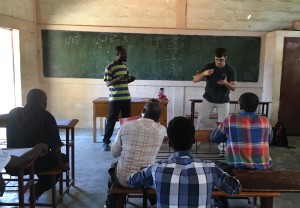AP in Haiti – Day Four: Hoops and Math
I love basketball. And today when I saw a hoop located outside the community center where we were doing home visits, I knew that I would be shooting some hoops today. Before that we were welcomed to the community by the local pastor. This is a community where The 410 Bridge had never visited before, so we were establishing relationships that would hopefully continue beyond our visit. The home visits were a chance to learn about the people of the community and pray for their hopes and dreams for themselves and for their children. When the home visits were done, the playground ball came out, and we shot some baskets (some what successfully).

In the afternoon I had a chance to work with the teachers of the community. In conversations with the leadership council and 410 Bridge it was decided that I would instruct the teachers on the basics of Cognitively Guided Instruction (CGI). CGI is a professional development program that directs teachers to examine the ways that children solve problems (e.g. basic arithmetic problems) and to help them progress in the complexity in which they solve those problems. A simple addition problem can be solved by counting out chips for each of the quantities to be joined together and then count out all the chips. Or that same problem can be solved by taking the first number provided and counting on the second number until the result is reached. Or because of familiarity with the numbers and their union the problem is no longer a problem and becomes a known fact. A teacher that is aware of such a progression can identify how a child solves that type of problem and use prompts and strategy sharing (from student to student) to help that progress to the next stage of complexity. In order to help the teachers understand these strategies we (my co-teacher/translator, Frantson, and I) translated some basic CGI terms into French Creole and prepared a brief professional development session where we would expose the teachers to the types of problems described in CGI and the common strategies associated with each of those types of problems. Then we explained each of the problem types, wrote examples on the board (which were very basic arithmetic problems) and then asked the teachers to consider how a student could model these problems with the two sided chips that we had brought. This was where it got fun. The teachers and community leaders (who were there to learn as well) wanted to share their strategies with me and each other. One of the ladies in the community was able to show me a method for solving a Change-Start Unknown problem that I had not seen before, which was very exciting. I wanted to model the type of excitement for strategy sharing that could happen in their classrooms. Students able to use their creativity to solve problems in different ways, which changes the emphasis from correct answers to varied processes. Overall the session was well received, at least that is what they told me. I learned a lot about the teachers, their abilities, and their challenges, and I believe they learned something from me as well.
Regardless, I got a chance to teach math teachers and shoot some hoops. That is a good day!


